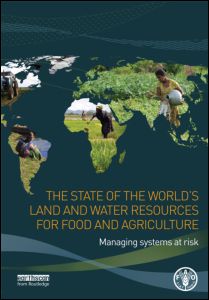
 The book ‘The State of the World’s Land and Water Resources for Food and Agriculture – Managing Systems at Risk’ summarises the current quantity, quality and socio-economic values of land and water around the global with respect to availability, risk and climate change. Policies, food production models and integrated management principles are all considered and discussed. Water is essential for food production and land suitable for meeting the challenges of feeding a hungry planet is increasingly demanded. This book presents the state of these resources and provides a global baseline for their future consideration and continued healthy, sustainable existence.
The book ‘The State of the World’s Land and Water Resources for Food and Agriculture – Managing Systems at Risk’ summarises the current quantity, quality and socio-economic values of land and water around the global with respect to availability, risk and climate change. Policies, food production models and integrated management principles are all considered and discussed. Water is essential for food production and land suitable for meeting the challenges of feeding a hungry planet is increasingly demanded. This book presents the state of these resources and provides a global baseline for their future consideration and continued healthy, sustainable existence.
The State of the World’s Land and Water Resources for Food and Agriculture
– Managing Systems at Risk
by
The Food and Agriculture Organisation of the United Nations
and
Earthscan
Earthscan
ISBN: 978-1-84971-327-6
294 pages – Published: 2011
(English)
Review by Jeff Thurston
The book ‘The State of the World’s Land and Water Resources for Food and Agriculture – Managing Systems at Risk’ (SQLAW) is the first of an expected series of reports on the state of the world’s land and water resources to be reported periodically – on a global basis. Aimed to senior managers, the vook summarises the quality, quantity, availability and socio-economic factors associated with land and water around the globe. It identifies challenges, needed policies and directions and is particularly oriented toward the production of food, which both depend upon available, and capable land as well as water. This book acts as a baseline for considering global change moving forward.
As Jacques Diouf, Director General of the FAO states “SQLAW also highlights the essential but often understated contribution that appropriate policies, institutions and investments make in assuring equitable access to resources and, their sustainable and productive management, while assuring acceptable levels of economic development. It also discusses options and strategies for addressing evolving issues such as water scarcity, and land degradation.”
The planet is under pressure as demands for scarce resources continue to grow. The amount of cultivated agricultural land and irrigated land have both doubled over the last 50 years. Fully 70% of the world’s fresh water originates from aquifers, rivers and lakes. By 2050, it is estimated that 70% more food will be needed due to a growing population.
The available, quantity and quality of land and water is not evenly distributed geographically. Some countries have more, others less, and in the case of food production, water is essential for growing crops. On top of this, the population distribution is also not evenly distributed, often the greatest numbers of people live in places with the least available resources or capability to produce them. Environmental requirements also place pressure on land and water.
“FAO defines land suitability for agriculture in terms of capacity to reach potentially attainable yields for a basket of crops,” and readers will be interested to learn that the highest proportion of land cultivated is in Latin America and the Caribbean, followed by western and central Europe.
The book is filled with excellent graphics, charts, tables and details about land and water, but it goes further by discussing how they are being managed, policy impacts and how they are assessed for values and risks. Readers will not only gain from the statistics and discussion, but the throughful progression of themes including land, water, soils, forests, climate, policy, demographics, infrastructure and development.
Institutional approaches and polices are highlighted in this book. They help to explain how these resources are managed and some of the considerations in their evolution both past and into the future. Technology is introduced in terms of resource management. It is presented in terms of increasing productive capability and capacity, providing directions and pathwys for consideration to improve agricultural production and increase the availability of food around the globe. Recommendations are included and the book attempts to describe incentives and investment possibilities for expanding land production and sustaining systems to assure resources will be available into the future.
In summary, this book is an excellent summary of the current state of the world’s land and water systems. It is much more that an aggregation of statistics, and liberal use of excellent graphics, maps, charts and tables together with well thought out explanations attempt to help readers understand.
The book is a necessity to anyone working with land and water. It is filled with information, knowledge and education about the current state of land and water in a global context. Moreover, it steps forward with provocative thinking, pushing the boundaries of conventional undertsanding to help readers appreciate and engage new possibilities for dwindling resources under growing demand. While I would have liked to have seen increased inclusion of geospatial tools and technologies for managing these resources, this book is exceptional for stating the situation for land and water and what we all need to be htinking about. This is one of the best books I have read on global resources.